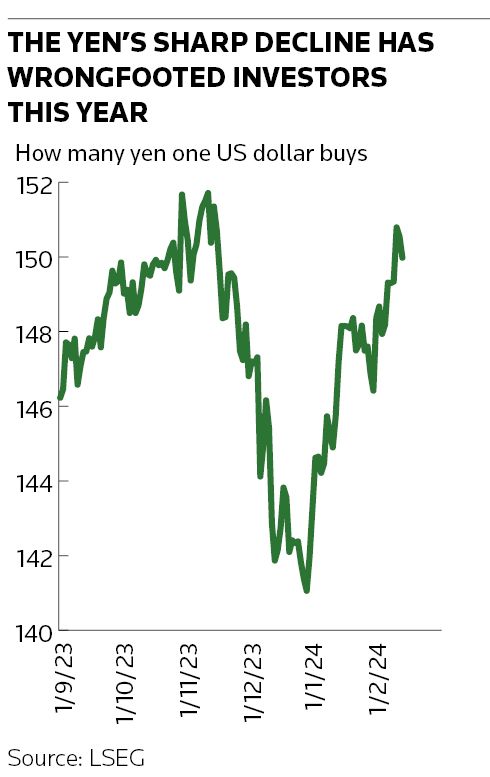Banks' foreign exchange traders are having a slow start to the year as the changing outlook for central bank interest rate cuts has caught out some investors and kept others on the sidelines.
Senior traders estimate FX volumes are down about 10% so far in 2024 compared with the same period last year as uncertainty over when the US Federal Reserve and other central banks will start to loosen monetary policy has depressed client activity. Average daily trading volumes in spot FX were 6% lower in January relative to a year ago on LSEG’s FXall trading platform at US$94bn.
Even though inflation has fallen, it hasn’t come down as quickly as people would have liked over the past two months, said Yakeen Mirchandani, head of emerging market FX trading at Nomura, which has prompted central banks to push back on rate cut expectations.
“That’s caused the FX market to become a bit wrong-footed, with some of the positions clients put on not going as expected,” said Mirchandani.
Central bank policy rates are one of the most important drivers of exchange rates. Raising interest rates usually pushes government bond yields higher, increasing their appeal for investors and encouraging them to buy the currency. Reducing interest rates typically has the opposite effect.
Stocks slumped, US Treasury yields jumped and the US dollar rose on Tuesday after a closely watched measure of US inflation came in hotter than expected, prompting investors to dial back bets on the Fed cutting rates in the coming months.
Stumbling
Traders say many hedge funds have stumbled after starting the year betting that the US dollar would fall against currencies such as the yen and those of some emerging markets, particularly in Latin America. Those trades haven’t fared well as the US Dollar Index is up 3% this year, reversing part of its 5% slide in the last two months of 2023.
Betting on a stronger yen has been a notable pain trade. The currency has fallen by more than 6% against the US dollar in 2024 after hopes faded that the Bank of Japan could raise interest rates early in the year.
"Convictions are low, vol [volatility] is low, and positioning is extremely low – as you would expect,” said Antony Foster, head of G-10 FX spot trading at Nomura. “The market hasn't really moved this year and people who are just starting their financial year are struggling to come up with anything definite that they want to sink their teeth into when it comes to a clear trend or theme within the FX market at the moment.”
Cooling off
FX volatility among G-5 currencies is currently at its lowest level since early 2022, according to CME Group's CVOL index.
The Fed, European Central Bank and the Bank of England all paused their hiking cycles in the second half of 2023 as inflation started to cool from multi-decade highs. Economists subsequently turned their attention to when central banks would pivot towards looser monetary policy as economic activity slowed.
But the timing and sequencing of who will move first – and when – has been a point of contention, with the US economy remaining resilient in the face of higher interest rates and inflation in the eurozone not slowing as quickly as people had hoped.
“We're in a peloton race of sorts around which central banks will be lowering their interest rates first, the result of which will dictate relative currency performance and impact FX market activity,” said Paul Mackel, global head of FX research at HSBC.
Hedging hesitancy
Corporate clients have also been hesitant to reactivate their hedging programmes, bankers say, due to some unexpected currency moves. The euro-US dollar FX rate has fallen from US$1.11 in late December to about US$1.08 on Friday, confounding analyst predictions that the euro could appreciate towards US$1.14 this year.
"That euro-dollar uncertainty has meant some clients have waited to restart their hedging programmes and are now considering when is best to hedge and how to hedge,” said Xavier Gallant, head of corporate FX and local market sales for EMEA at BNP Paribas.
For those who have started to hedge, many are turning towards options products, said Gallant – with clients happily paying a premium for the ability to unwind their hedges prior to maturity, and to recuperate any remaining value in the option, should FX rates further decrease.
Low FX market volatility has driven options costs down this year, increasing the appeal of these derivatives among corporate clients. BNPP said it has transacted 50% more FX options volumes with clients this year despite a broader decline in FX volumes, with two-thirds of this options activity coming in euro-dollar transactions.
“We’re now seeing different clients using options, particularly those … who are looking for a way to cope with ongoing FX market and geopolitical uncertainties,” said Frederic Han, deputy head of FX structuring for EMEA at BNPP.
The low FX market volatility has driven options costs down this year, increasing the appeal of these derivatives among corporate clients. Some corporates are also favouring so-called participating forwards for hedges, which don’t require an upfront premium payment like options do.
“Some people aren’t used to paying upfront for their hedges when using options, hence the use of participating forwards as that gives you a hedge without having to pay cash on day one,” said Jackie Bowie, head of EMEA at hedging advisory Chatham Financial.
